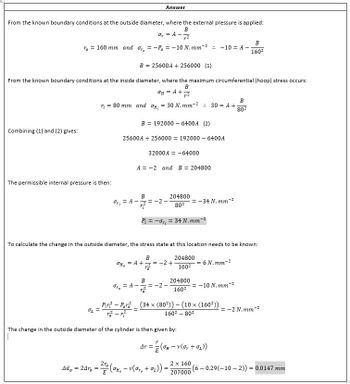A thick walled cylinder, of internal diameter 160 mm and external diameter 320 mm, is subject to an internal and external pressure as shown in Figure 1. If the external pressure is 10 MPa and the maximum circumferential (hoop) stress permitted on the inside wall of the cylinder is limited to 30 N.mm-2, what is the maximum internal pressure that can be applied? A) What is the maximum internal pressure that can be applied? B) What will be the change in the outside diameter when this pressure is applied? (E = 207 GPa, ν = 0.29)
A thick walled cylinder, of internal diameter 160 mm and external diameter 320 mm, is subject to an internal and external pressure as shown in Figure 1. If the external pressure is 10 MPa and the maximum circumferential (hoop) stress permitted on the inside wall of the cylinder is limited to 30 N.mm-2, what is the maximum internal pressure that can be applied?
A) What is the maximum internal pressure that can be applied?
B) What will be the change in the outside diameter when this pressure is applied? (E = 207 GPa, ν = 0.29)

Trending now
This is a popular solution!
Step by step
Solved in 4 steps

Hi,
Thank you for the solution on this, we have been taught in university an alternative way of tackling this problem and it results in different final answers, please see in image attached. Now im wondering which one is correct? this is a new subject to us and im hoping to better understand the principles and workings of this, I come to bartleby to offer alternate ways of solving problems to better my understanding of given concepts. Does this example read true to yourself or is your way the correct way according to an external verified reference? Thanks again!









